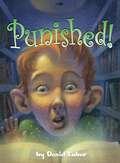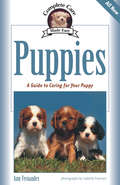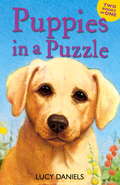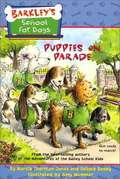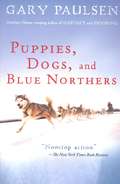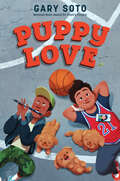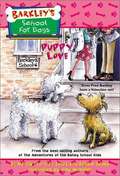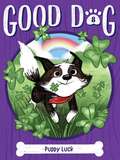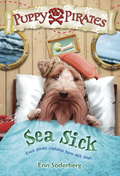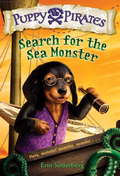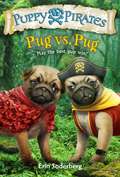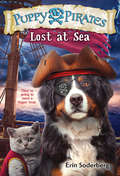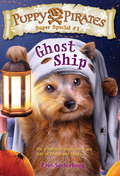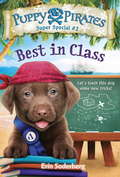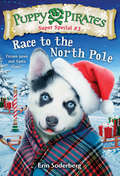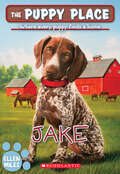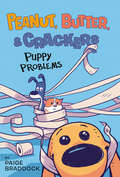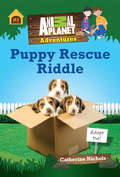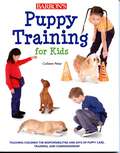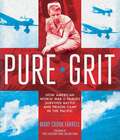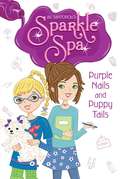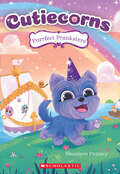- Table View
- List View
Punished! (Exceptional Reading And Language Arts Titles For Intermediate Grades Ser.)
by David LubarLogan and his friend Benedict run into the wrong guy at the library―literally. When Logan slams into the reference guy in the basement and gives him a little lip, Logan gets punished, really and truly punished. He has three days to complete three tasks before Professor Wordsworth will lift the magical punishment that keeps getting Logan in even more trouble.
Puppies
by Isabelle Francais Amy FernandezComplete Care Made Easy books address all the major concerns about owning and training a small pet. Each care book offers practical advice, emergency first aid tips, fun activities, and more! Look to the training titles for in-depth training techniques and helpful tips.
Puppies in a Puzzle: Dalmatian in the Dales & Labrador on the Lawn
by Lucy DanielsLABRADOR ON THE LAWN: Mandy and James are staying with her parents at a holiday cottage in the Lake District when they spot a mischievous Labrador on their lawn. James's dog Blackie is delighted to have found a friend, but with no identification or collar, how will the Hopes find her owner? And why does she seem so at home in the cottage?DALMATIAN IN THE DALES: On their way to investigate deer poachers operating nearby, Mandy and James discover a confused and footsore Dalmatian named Echo. Now it isn't just the deer that are in trouble. Can Mandy help Echo's owners to work out why their dog has suddenly started running away?
Puppies on Parade (Barkley's School for Dogs #12)
by Debbie Dadey Marcia Thornton JonesThe Barkley's School for Dogs will be marching in the town's 100th anniversary parade ... and so will another neighborhood canine school, Howl's Dog City. Jack and his friends are set on outshining their rivals. But having fun and getting along beats competition, paws down!
Puppies, Dogs, and Blue Northers: Reflections on Being Raised by a Pack of Sled Dogs
by Gary PaulsenAn experienced Iditarod racer, Gary Paulsen celebrates his lead dog and longtime companion, Cookie, in this intimate essay. Paulsen takes readers inside the kennel as Cookie’s last litter of pups grow and learn to pull sleds across the snowy frontier. Includes an author's note.
Puppy Love
by Gary SotoA sweetly humorous middle grade novel packed with action, basketball, and a dash of magical realism about friendship and family, first crushes, and belonging, from acclaimed author Gary Soto.Thirteen-year-old Jordan Mendoza has a huge crush on his classmate, Sierra, but he’s never going to win her affections if he stays a C student and keeps embarrassing himself on the basketball court. And it doesn’t help that his best friend, Antonio, likes to tease him about it all a little too much.But when Jordan dives into the waters of a dangerous irrigation canal to save a drowning puppy, he’s suddenly got even more on his mind than kissing Sierra and making the starting team. Can he nurse the abandoned puppy back to health (and will his parents let him keep her)? Who threw her into the canal—and is it possible that there are more puppies needing rescue? And why are the cops suddenly at Jordan’s door, looking for him? There’s something for every reader in this story’s mix of humor, sports, themes of thrilling independence, subtle strands of magical realism, and timely social commentary, all held together by a sweet and satisfying emotional core.
Puppy Love (Barkley's School for Dogs #11)
by Debbie Dadey Marcia Thornton JonesThe local vet is hanging around Barkley School, and the dogs aren't too thrilled. Blondie thinks that the doc is there to see Fred--it's more than puppy love for those two humans! But when Tazz gets hurt, having a doctor nearby is the best thing for all the dogs at Barkley.
Puppy Love Prank (Nancy Drew Clue Book #13)
by Carolyn KeeneNancy and her friends save a dog shelter&’s big day in the thirteenth book in the interactive Nancy Drew Clue Book mystery series.Helga and Horatio are getting married! The bride and groom are two fluffy white dogs belonging to one of River Heights&’s more eccentric citizens, Mrs. Ainsworth. Mayor Strong&’s mansion is decorated for the occasion, and the whole town is invited. The celebration is an effort to raise awareness for Waggamuffins, the local pet shelter. And Nancy, Bess, and George are helping out by walking three adoptable dogs down the aisle. But the wedding comes to a barking halt when the bride and groom are found covered in sticky paint! Mrs. Ainsworth is so upset she calls off the whole thing and demands to know who is behind this color conundrum. But if the guests leave early, how will they meet all the cuddly canines that still need homes? Can the Clue Crew solve the case of the painted pups before it&’s too late? It&’s up to the Clue Crew—and you—to find out!
Puppy Luck (Good Dog #8)
by Cam HigginsIn the adorable eighth book of the Good Dog series, Bo tests his luck!There are plenty of sunny, good luck days on the farm. But sometimes, stormy bad luck clouds come around too, and Bo will need all the puppy luck he can find to chase those clouds away. With easy-to-read language and illustrations on almost every page, the Good Dog chapter books are perfect for emerging readers.
Puppy Pirates #4: Sea Sick
by Erin SoderbergAhoy, mateys! Set sail for fun and adventure on a pirate ship full of puppies. Oh no! Captain Red Beard can't get out of bed. He's got the chills and a fever! Without their captain to bark out orders, will the puppy pirates run into trouble? Or will First Mate Curly keep everything shipshape? Two perennial kid favorites--dogs and pirates--combine in the new chapter book series perfect for fans of Rainbow Magic, Jake and the Neverland Pirates, and Paw Patrol.
Puppy Pirates #5: Search for the Sea Monster
by Erin SoderbergAhoy, mateys! Set sail for fun and adventure on a pirate ship full of puppies. It's hide-and-seek . . . with a sea monster?! The puppy pirates are embarking on a quest to find a mysterious monster far out at sea. This epic adventure takes bravery and smarts--and no one suspects that their quiet new crewmate, Einstein, could be the hero of the day. But then again, you can't judge a pup by his fur!From the Trade Paperback edition.
Puppy Pirates #6: Pug vs. Pug
by Erin Soderberg Erin Soderberg DowningAhoy, mateys! Set sail for fun and adventure on a pirate ship full of puppies. It’s pug-o’-war! Piggly and Puggly are usually too busy playing pranks to argue. But when the puppy pirates get stranded on a cold, rainy island, the twin sisters can’t agree on anything. Wally and the others are forced to choose sides in an all-out pug showdown! Which pug’s team will win this dogfight and survive the night? Two perennial kid favorites—dogs and pirates—combine in this chapter book series perfect for fans of Rainbow Magic, Jake and the Neverland Pirates, and Paw Patrol.
Puppy Pirates #7: Lost at Sea (Puppy Pirates #7)
by Erin SoderbergAhoy, mateys! Set sail for fun and adventure on a pirate ship full of puppies.SOS! Wally and the Puppy Pirates know the legends and mysteries about the Grr-muda Triangle, but could all those strange stories be true? There's only one way to find out: the Salty Bone is going to sail straight through the Grr-muda Triangle! Will the crew make it out alive? Or will they be lost at sea forever . . . ?
Puppy Pirates Super Special #1: Ghost Ship (Puppy Pirates #1)
by Erin SoderbergFans of PAW Patrol and Rainbow Magic and those looking for Halloween chapter books will want to climb aboard this PUPPY PIRATES SUPER SPECIAL! Ahoy, mateys! Set sail for fun and adventure on a pirate ship full of puppies! Boo! When Wally is pranked by a couple of pugs, they accuse him of being more puppy than pirate. How can Wally prove he&’s as fearless as the rest? Spending the night on an abandoned pirate ship should do the trick! But when Wally and his human friend, Henry, climb aboard, they soon discover the ship might not be so empty after all. . . .This super edition features exciting content like:- How to Draw a Puppy Pirate!- Puzzles!- Instructions for how to play the "Puppy Pirates vs. Kitten Pirates" game!And don't miss the other adventures of the Puppy Pirates!
Puppy Pirates Super Special #2: Best in Class (Puppy Pirates #2)
by Erin SoderbergGo back to school with the puppy pirates! Welcome aboard! There is a new pup joining the crew of the Salty Bone. She is super excited, but she doesn’t know the first thing about being a pirate. Luckily, Wally and the other pups will teach her—at pirate school! Mast climbing, map reading, survival skills . . . there is a lot to learn. Will the puppies pass the test? This second super special is filled with fun and games, including how to draw a puppy pirate!
Puppy Pirates Super Special #3: Puppy Pirates Super Special #3 (Puppy Pirates #3)
by Erin SoderbergFrozen paws and Santa Claus! The Puppy Pirates are back with this exciting holiday special.Dashing through the snow, in a puppy pirate sleigh . . . Captain Red Beard has always wanted to compete in the Great Ice Race at the North Pole. After all, the prize is rumored to be the biggest treasure ever! But can a bunch of warm-weather pirate pups really win a snowy sled race? This magical holiday special edition contains extra pirate adventure and a holiday treasure of an ending that will warm young readers' hearts!
Puppy Place, The #47: Jake (The Puppy Place #47)
by Ellen MilesCharles and Lizzie Peterson love puppies. Their family fosters these young dogs, giving them love and proper care, until they can find the perfect forever home. Lizzie goes to horse camp with her best friend Maria. While there, Lizzie meets a charismatic German shorthair pointer named Jake. The puppy is very curious about the farm and especially likes to spend time with the horses. Can Lizzie help find Jake a perfect home?
Puppy Problems (Peanut, Butter, And Crackers Ser.)
by Paige BraddockA goofy new puppy rocks the world of a high-strung dog and a snarky cat in this hilarious graphic novel for early readers.Crackers is a rescue dog who's a bit on the nervous side, but pretty comfy at home with Butter, a very plump cat who--like all cats--is all about himself. The two pets have a good life: big backyard, nice couch, good eats, and an owner who goes to work every day so they can pretty much do what they want.Enter Peanut, a brand-new puppy with big floppy ears, unabashed energy, and no appreciation for the quiet life. The little dog is a chowhound who dips into everybody's food bowl. He drools, he chews up stuff, he doesn't get how stairs work, and he's afraid of the dark. Yowl! Not to mention he's hogging their owner's lap. Even the squirrels in the yard are laughing at this goofy little canine.Butter and Crackers have had it! This puppy has to go! But when the backyard gate is left open (the cat's idea, of course!) and Peanut wanders out and gets lost, the older animals remember what it was like to be alone--and lonely. Butter and Crackers to the rescue!Kids will laugh-out-loud at Paige Braddock's funny, endearing art and dialogue. (She also cleverly never shows "our human," the animals' owner, as anything more than a pair of hands or unintelligble speech balloons.) This is a wonderful story about friendship and acceptance, with the funniest combination of pets to ever hit the page.
Puppy Rescue Riddle (Animal Planet Adventures Chapter Books #3)
by Animal Planet Catherine NicholsANIMAL PLANET Adventures chapter books present nonfiction information within a familiar narrative format to bring the best of the animal world to young readers.A storm is coming to coastal North Carolina. Amy and Elliott - volunteers at the local dog shelter - have a job to do. The rescued puppies need to get to higher ground, and fast! The kids scramble to get the puppies into their cages, and then the van of volunteers and dogs is on its way. But they are one puppy short. Did it run off in the rain? Is it back at the shelter? An old book, a series of riddles, and a spooky storm all lead to a mystery only the kids can solve.
Puppy Stories
by Michael J. Pellowski[from the back cover] "THREE PUPPIES, who are nobody's puppies, set out to find masters to love ... a hunting puppy hunts for dinner for his family and brings home three surprises ... a St. Bernard doesn't want to be a rescue dog ... a German Shepherd pup' wants more than anything in the world to be a watch puppy ... a puppy who does nothing but "sit" finds a job with the circus."
Puppy Training for Kids: Teaching Children the Responsibilities and Joys of Puppy Care, Training, and Companionship
by Colleen PelarA helpful puppy training book to introduce kids (and the whole family!) to the joys and responsibilities that come with bringing a new puppy home. All the essentials of dog training are here!Topics covered include:Purchasing puppy suppliesHouse training and socializing your puppyUnderstanding your puppy's behavior and body languageKeeping your puppy out of troubleThe basics of puppy trainingFun and games with puppiesYoung readers will find advice on exercise, selecting chew toys, clicker training, teaching the puppy to meet both human and animal friends, and much more. Sidebar features advise parents on guiding their children toward responsible dog ownership. The book is filled with engaging and instructive color photos.
Pure Grit: How American World War II Nurses Survived Battle and Prison Camp in the Pacific
by Mary Cronk FarrellIn the early 1940s, young women enlisted for peacetime duty as U.S. Army nurses. But when the Japanese attack on Pearl Harbor in 1941 blasted the United States into World War II, 101 American Army and Navy nurses serving in the Philippines were suddenly treating wounded and dying soldiers while bombs exploded all around them. The women served in jerry-rigged jungle hospitals on the Bataan Peninsula and in underground tunnels on Corregidor Island. <p><p> Later, when most of them were captured by the Japanese as prisoners of war, they suffered disease and near-starvation for three years. Pure Grit is a story of sisterhood and suffering, of tragedy and betrayal, of death and life. The women cared for one another, maintained discipline, and honored their vocation to nurse anyone in need―all 101 coming home alive.
Purple Nails and Puppy Tails
by Jill SantopoloWhen Aly and Brooke decide to give PET-icures to puppies, it seems like their new Sparkle Spa salon might just go to the dogs!At Aly and Brooke's new nail salon, anything goes. Well, almost anything. One of their mother's regular clients doesn't go anywhere without her beloved dog Sadie, who's a canine star. One paw leads to another, and the girls not only polish Sadie's nails, but also hatch a scheme to do doggy makeovers for the Annual Pup Adoption Day at the local shelter. But dogs aren't exactly ideal mani-pedi customers, are they? The girls are finding out the ruff way!
Purple Nails and Puppy Tails (Sparkle Spa #2)
by Jill SantopoloWhen Aly and Brooke decide to give PET-icures to puppies, it seems like their new Sparkle Spa salon might just go to the dogs! At Aly and Brooke’s new nail salon, anything goes. Well, almost anything. One of their mother’s regular clients doesn’t go anywhere without her beloved dog Sadie, who’s a canine star. One paw leads to another, and the girls not only polish Sadie’s nails, but also hatch a scheme to do doggy makeovers for the Annual Pup Adoption Day at the local shelter. But dogs aren’t exactly ideal mani-pedi customers, are they? The girls are finding out the ruff way!
Purrfect Pranksters (Cutiecorns)
by Shannon PenneyMeet the Cutiecorns, adorable puppies with magical horns who get into all kinds of enchanting adventures.Puppypaw Island is being pranked, and Flash doesn't like it one bit! Someone has ruined the pups magic lesson and tried to sabotage movie night. When the prankster goes too far, Flash decides to take matters into her own paws. Can the Cutiecorns catch the joker and stop the chaos before Puppypaw Island is turned snout-side down?
